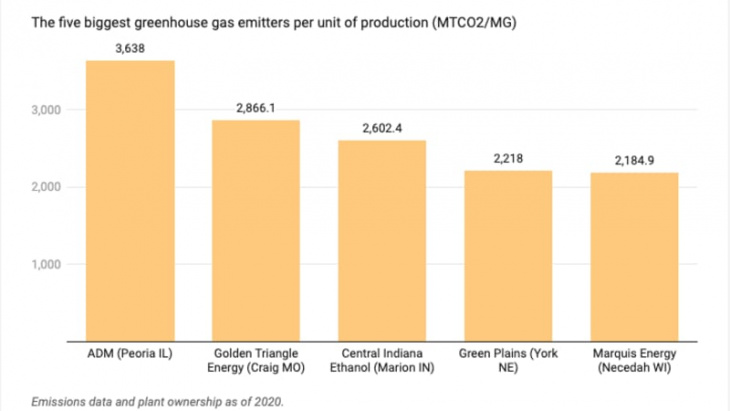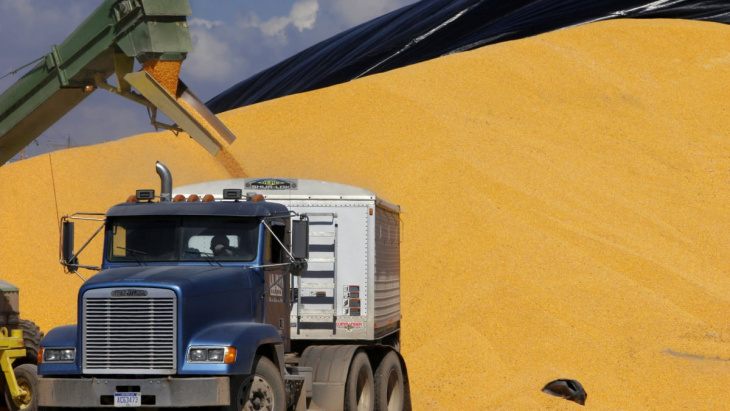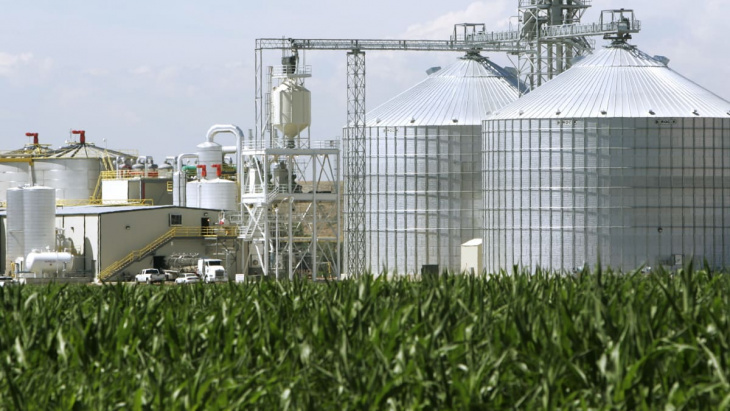
WASHINGTON — In 2007, the U.S. Congress mandated the blending of biofuels such as corn-based ethanol into gasoline. One of the top goals: reducing greenhouse gas emissions.
But today, the nation’s ethanol plants produce more than double the climate-damaging pollution, per gallon of fuel production capacity, than the nation’s oil refineries, according to a Reuters analysis of federal data.
The average ethanol plant chuffed out 1,187 metric tons of carbon emissions per million gallons of fuel capacity in 2020, the latest year data is available. The average oil refinery, by contrast, produced 533 metric tons of carbon.
The ethanol plants’ high emissions result in part from a history of industry-friendly federal regulation that has allowed almost all processors to sidestep the key environmental requirement of the 2007 law, the Renewable Fuel Standard (RFS), according to academics who have studied ethanol pollution and regulatory documents examined by Reuters. The rule requires individual ethanol processors to demonstrate that their fuels result in lower carbon emissions than gasoline.
The Environmental Protection Agency (EPA) is charged with writing the regulations to meet the goals set by Congress. For processors, that translates to an EPA requirement that the plants use certain emissions-control processes the agency assumes will result in lower-than-gasoline emissions.
But the agency has exempted more than 95% of U.S. ethanol plants from the requirement through a grandfathering provision that excused plants built or under construction before the legislation passed. Today, these plants produce more than 80% of the nation’s ethanol, according to the EPA.
Among the five biggest polluters in 2020, per gallon of fuel capacity, were plants owned by Archer-Daniels-Midland Co, Golden Triangle Energy, Central Indiana Ethanol, Green Plains Inc and Marquis Energy, according to the Reuters analysis. Plants operated by major energy companies POET LLC and Valero Energy Corp were among the top 15.

Green Plains, Marquis and POET said that ethanol is cleaner than gasoline, despite higher plant-level emissions, when all factors are considered, including emissions from fuel consumption in vehicles. The other companies did not respond to requests for comment.
Some of the exempted plants produced much less pollution, including some owned by the same companies producing the highest emissions. The EPA said about a third meet the law’s environmental standard even though they are not required to do so. But as a group, the plants freed from regulation produced 40% more pollution per gallon of fuel capacity, on average, than the plants required to comply, the Reuters analysis found.
The EPA’s resolve to rein in ethanol emissions faces a new test this year as Congressional mandates for expanding biofuels expire, placing the future of the RFS at the agency’s discretion. The EPA is expected to propose regulatory changes later this year but has yet to publicly detail any proposed revisions.
The ethanol mandate was “just a mistake,” said Timothy Searchinger, a senior researcher at Princeton University’s Center for Policy Research on Energy and the Environment. “We created a terrible model.”
White House representatives of Democratic U.S. President Joe Biden, who has vowed to aggressively fight climate change, did not comment on the Reuters findings on ethanol emissions. In response to Reuters inquiries, the EPA said it has followed the intent of Congress in implementing the biofuels law, including the regulatory exemptions. The agency acknowledged the higher production emissions of ethanol, compared to gasoline, but asserted that ethanol is cleaner overall.
The agency also touted ethanol’s benefits on rural economies and national security. “Renewable fuels help diversify our nation’s energy supply, improving energy independence and security,” the agency said, adding that biofuels provide “good paying jobs and income to farming communities.”
Ethanol industry representatives have recognized the need to lower the biofuel’s carbon emissions, and biofuel producers have been investing in projects that would capture plants’ carbon emissions and bury them permanently underground.
The leading ethanol industry group maintains, however, that ethanol is cleaner than gasoline. “Ethanol offers a significant and immediate carbon savings,” said Geoff Cooper, president of the Renewable Fuels Association (RFA), in a statement to Reuters.
Other industry observers say the RFS has utterly failed to meet its stated environmental goals. The ethanol mandate was “just a mistake,” said Timothy Searchinger, a senior researcher at Princeton University’s Center for Policy Research on Energy and the Environment. “We created a terrible model.”

Disputed government research
Ethanol does have a key environmental advantage over gasoline: It burns cleaner in cars. The problem, biofuels researchers have found, is that those gains are offset by the pollution from planting corn and refining it into fuel.
Researchers from industry, government and academia seek to account for all these dynamics in estimating ethanol’s pollution throughout its full “life cycle” — from farms to processing plants to automobile tailpipes.
The Reuters analysis examined one major part of that cycle – ethanol processing – based on the emissions data that most plants are required to report to the EPA. The data provides the only view of ethanol emissions tied to individual processors, allowing for comparisons among ethanol plants subject to the emissions-reduction regulation, those exempt from it, and their counterparts in oil refining.
Ethanol does have a key environmental advantage over gasoline: It burns cleaner in cars. The problem, biofuels researchers have found, is that those gains are offset by the pollution from planting corn and refining it into fuel.
Government and academic researchers have also sought to estimate the industry’s overall pollution, but they have come to sharply contrasting conclusions.
A growing consensus of academics has found that, considering all phases of the fuel’s life cycle, ethanol produces more carbon than gasoline — not less. A study published by the National Academy of Sciences in February, for example, estimated that ethanol produces 24% more carbon.
The EPA’s methodology, by contrast, has hewed closer to the findings of industry-commissioned studies, which assert that ethanol produces as much as 40% less lifecycle emissions than gasoline. The EPA has used a controversial methodology to estimate the ethanol industry’s life-cycle emissions that has effectively ensured the industry’s continuing regulatory compliance. The model greatly underestimates the industry’s pollution from corn agriculture, four academic researchers of ethanol told Reuters.
The EPA methodology relies in part on the work of a researcher from Purdue University in Indiana, whose model the agency selected at the ethanol industry’s suggestion, regulatory documents show.
The RFA said the Reuters analysis of processing-plant pollution inappropriately focused on only one aspect of the industry’s pollution profile and disputed the findings of independent academic researchers showing the overall life-cycle emissions of ethanol are higher than gasoline. Cooper, the association’s president, concluded that “the science is clear,” showing overall ethanol emissions are “40-50% lower than gasoline.”
Exemptions for polluters
The ethanol industry’s high emissions are caused in part by the exemptions the EPA has granted to almost all ethanol plants, academic researchers said.
The law requires that the ethanol industry demonstrate that the fuel delivers a 20% reduction in carbon emissions compared with gasoline. The percentage is based on the EPA’s model for estimating emissions from all phases of the fuel’s life cycle, including agricultural and fuel consumption. But individual processing plants can meet the standard by agreeing to certain EPA-stipulated emissions-control practices.
Congress initially required the exemptions, but the EPA had broad authority to interpret the law. Several environmental groups asked the agency early on to set an expiration date for the exemptions, or to terminate exemptions for plants that are substantially upgraded or expanded. The agency declined, regulatory records show. The EPA argued in documents outlining the final rule in 2010, for example, that terminating an upgraded plant’s exemption status would require an agency evaluation that would be too “time consuming.”
The legacy of the exemptions is apparent at the Vantage Corn Processors ethanol plant, a hulking complex of steel silos, storage tanks and brick factory buildings that dominates the riverfront in downtown Peoria, Illinois, near the heart of the U.S. corn belt.
Ethanol plants complying with the rule produced an average of 860 metric tons of carbon per millions of gallons of fuel capacity, compared to 533 tons at the average oil refinery. The average exempted ethanol plant produced 1,203 tons of carbon.
The facility was among the dirtiest U.S. ethanol plants, according to a Reuters analysis of EPA data. The plant cranked out more than 3,600 metric tons of carbon dioxide – seven times more than the average oil refinery – for every million gallons of fuel produced.
The plant was owned in 2020 by ADM, the multinational food processor and agricultural trader, and was purchased the following year by BioUrja Group, a global energy firm. BioUrja’s chief operating officer, Shék Jain, said the data analyzed by Reuters reflects emissions under ADM ownership and that his company is making the plant more efficient. ADM did not comment.
The Peoria plant is among 240 of 251 U.S. ethanol production facilities that are exempted from emissions-reduction requirements, EPA data show.
Reuters analyzed 165 of the exempted facilities, those for which both production and emissions data were available. The remaining facilities are not required by federal law to report their pollution levels because their carbon emissions were below 25,000 metric tons annually. Generally, that indicates they are small processing facilities.
While the small number of ethanol plants subject to regulation produce 40% less pollution than the exempted plants, they still produce more pollution, on average, than oil refineries, the Reuters analysis found. Ethanol plants complying with the rule produced an average of 860 metric tons of carbon per millions of gallons of fuel capacity, compared to 533 tons at the average oil refinery. The average exempted ethanol plant produced 1,203 tons of carbon.
The grandfathered facilities produced 4.8 million tons more carbon emissions than they would have if they had been required to comply with the standard, according to a Reuters calculation based on the average emissions from regulated and unregulated plants. That’s equivalent to the emissions of more than a million cars.

Industry-friendly assumptions
The U.S. government has maintained that ethanol produces less pollution than gasoline despite the growing body of independent research showing the opposite. The EPA bases its claim that ethanol benefits the climate on calculations made nearly 15 years ago using a handful of scientific models. The models include one that was recommended to the agency by the Renewable Fuels Association, agency documents show.
When Congress passed the RFS, it required the EPA to model ethanol’s emissions profile to verify it could meet the emissions-reduction standard. The EPA’s first pass at the calculation in 2009, however, found that ethanol would result in a 5% increase in greenhouse gas emissions over gasoline, which would have barred the fuel from the blending mandates.
Industry groups including the RFA bristled at the calculation and urged the agency to change the formula. The industry recommendations included adopting a model maintained by the Global Trade Analysis Project (GTAP) at Purdue University to estimate the pollution generated by planting corn for ethanol, EPA records of the debate show.
The EPA redid its modeling and used GTAP to test its results, according to a 2010 Congressional Research Service report. It concluded ethanol’s emissions were 21% lower than gasoline – putting the biofuel just barely over the 20% threshold for RFS compliance.
The agency told Reuters that it did not make the modeling change solely at the industry’s request, but rather included input from “government, academia, industry, and not-for-profit institutions.”
The Purdue model’s approach to estimating agricultural emissions has been disputed by academics.
The bulk of ethanol emissions are produced when new land is tilled for corn production, releasing carbon that is stored in soil and roots. Two biofuel experts told Reuters that the team working on the Purdue model has steadily reduced its estimate of how much carbon is released from tilled land over the years, making ethanol appear more climate-friendly. For instance, the model has been adjusted over the past decade to overstate increases in corn yields, resulting in an underestimate of emissions from planting, according to a study published in 2020 by the Journal of Cleaner Production, an academic publication focused on sustainability.
The changes raise concerns about the model’s credibility and result in a “really lowball estimate” for agricultural emissions from ethanol, said Stephanie Searle, director of the fuels program at the International Council on Clean Transportation, a nonprofit research organization.
The Purdue model is led by Dr. Farzad Taheripour, a researcher and professor of agricultural economics. Taheripour said the model was modified over time to reflect real-world observations of how biofuels production has affected land use. For instance, early scholarship on ethanol regulation suggested the RFS would lead to deforestation, which did not occur, he said.
Taheripour has received research funding from several biofuels industry trade groups since 2012, including the Renewable Fuels Association, National Corn Growers Association, Indiana Corn Soybean Alliance, and National Biodiesel Board, according to a Reuters review of his research funding disclosures.
Reuters was not able to determine the total amount of industry grants Taheripour has collected or the amount he may have received from other sources. Taheripour said his funding sources do not affect his research methods or outcomes.
Land conversion
When Congress passed the RFS, it barred farmers from planting previously uncultivated acres with corn for ethanol, a measure intended to limit carbon emissions. And biofuels supporters often point to the fact that overall U.S. corn acreage has stayed relatively stable since the passage of the biofuels law in 2007.
Some scientists counter that corn planting would have dropped significantly without the government biofuels mandate. In the 25 years before the law’s passage, corn acreage declined nearly 7%, due in part to increasing yields per acre.
Moreover, corn acreage statistics do not account for millions of acres of corn for ethanol being planted on new lands — the result of another EPA regulation that relaxed restrictions on the industry.
During its initial RFS rulemaking, the agency allowed new corn planting for ethanol on land enrolled in the U.S. Department of Agriculture’s Conservation Reserve Program (CRP), which pays farmers a monthly rent to keep fragile land idle.
Since then, farmers have planted about 5 million acres of conserved land with corn for ethanol, according to the National Academy of Sciences study. All that planting comes with “a carbon cost,” said Tyler Lark, a scientist at the University of Wisconsin-Madison’s Center for Sustainability and the Global Environment and the study’s lead author.
Taheripour dismissed the idea that the ethanol industry’s new corn plantings produced much pollution.
“CRP land is nothing but unused cropland,” Taheripour said. “Unused land does not have the capability to capture lots of carbon.”
The USDA has for years claimed otherwise – that unused farmland in its CRP program soaked up massive amounts of carbon. Touting the program as a major solution to climate change, the department estimated between 2006 and 2017 that such lands contained about 1.4 metric tons of carbon per acre, on average.
Asked about the climate benefits of CRP land for this story, however, the USDA told Reuters it had recently lowered its estimate of carbon in such lands by nearly half, to 0.8 metric tons per acre, after reviewing updated data.
Given the scientific disputes surrounding ethanol, industry and governmental claims of a major climate benefit are dubious, said Rich Plevin, an environmental consultant and former researcher at the University of California-Berkeley who has studied biofuels emissions.
“Did the policy achieve anything? I think it’s really hard to claim that it did for the environment,” he said. “The best we can say is, no one really knows.”
Keyword: How U.S. regulators allow ethanol plants to pollute more than oil refineries
